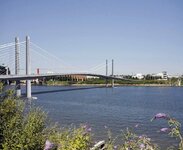Bronze Supporter
- Messages
- 6,741
- Reactions
- 21,483
From the hideous salt mine with windows where I toil in downtown Portland, I've been watching the new light rail bridge (Tilikum Crossing) going up across the Willamette River from both sides, to eventually join in the middle. Viewed from a mile away, it appears that the two sides have finally met. So here's what I've been wondering:
With all kinds of lasers, GPS and technology that I can't even begin to understand, shall I assume the two spans joined perfectly mid-river when they finally met? Even with precision aiming gear, shift happens, yes? Did they need some bending/fudging to line up when it was time to touch? If they weren't right on, how far off where they?
Was anyone here standing right there when they came together?
With all kinds of lasers, GPS and technology that I can't even begin to understand, shall I assume the two spans joined perfectly mid-river when they finally met? Even with precision aiming gear, shift happens, yes? Did they need some bending/fudging to line up when it was time to touch? If they weren't right on, how far off where they?
Was anyone here standing right there when they came together?
Last Edited:












